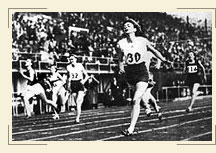|
 The invincible Marjorie Jackson
The invincible Marjorie Jackson
She gave up sport in 1954, when she was only 23 years old, having already a career of 5 years to her credit with many distinctions in international  games, 10 times breaking the world record and two gold medals in the Games of 1952, in the 100m and the 200m. What is more, if one of her teammates in the 4x100m relay had not hampered her, she would have probably won one more gold medal, following the steps of Fanny Blankers-Koen four years earlier in London. Besides, her consecutive victories over the "flying housewife", as Blankers-Koen had been called after the Games of 1948, were the beginning of Jackson's brief but impressive presence in sport. games, 10 times breaking the world record and two gold medals in the Games of 1952, in the 100m and the 200m. What is more, if one of her teammates in the 4x100m relay had not hampered her, she would have probably won one more gold medal, following the steps of Fanny Blankers-Koen four years earlier in London. Besides, her consecutive victories over the "flying housewife", as Blankers-Koen had been called after the Games of 1948, were the beginning of Jackson's brief but impressive presence in sport.
She was born on 13 September 1931 in Coffs Harbour, Australia, but grew up in Lithgrow, a city that had supported her preparation and journey to Helsinki in many ways. She took up sport during her school years and at the age of fifteen she excelled in the school championship. The first important games in which she participated were the preliminaries for the constitution of the Olympic team of Australia in 1948. She was only 17 years old and although she already had the best performance, she did not make it among the three first that would travel to London. In reality she did not run at all, because she thought that she had a false start. A few months later, after the Olympic Games, Blankers-Koen came to Australia and took part in games that had also a celebrating character for her performances in London. In all three games Jackson was the winner, and even achieved a better performance that that of Blankers-Koen in the 100m final in London.
Jackson's first significant distinction was in 1950, in the Commonwealth games, where she gained four victories. Then began her preparation for the Helsinki Olympics. Jackson was an ideal amateur of sport. She continued living in a relatively small city that did not have the necessary sports infrastructures for the preparation of athletes for major Games. At the same time, she continued working and trained at night. Despite all that and thanks to the support by her co-citizens, a track was made of charcoal powder fit for training, but there was no electricity supply. Therefore, she trained at night and had the headlights of a car cast their light on one spot of the track.
And that was not the only problem. The Australian federation could afford the expenses of only 35 athletes, among who only two would be women and therefore they would not be able to participate in the 4x100m relay. So Jackson had to work more to gather money. Eventually, 10 female athletes made it to Helsinki. There, apart from the two gold medals won by Jackson, Shirley Strickland won a gold in the 80m hurdles and a bronze in the 100m. A mishap in the relay deprived the Australian team of yet another medal, a gold probably. Two years later Jackson gave up sport, without having experienced any defeat.
|